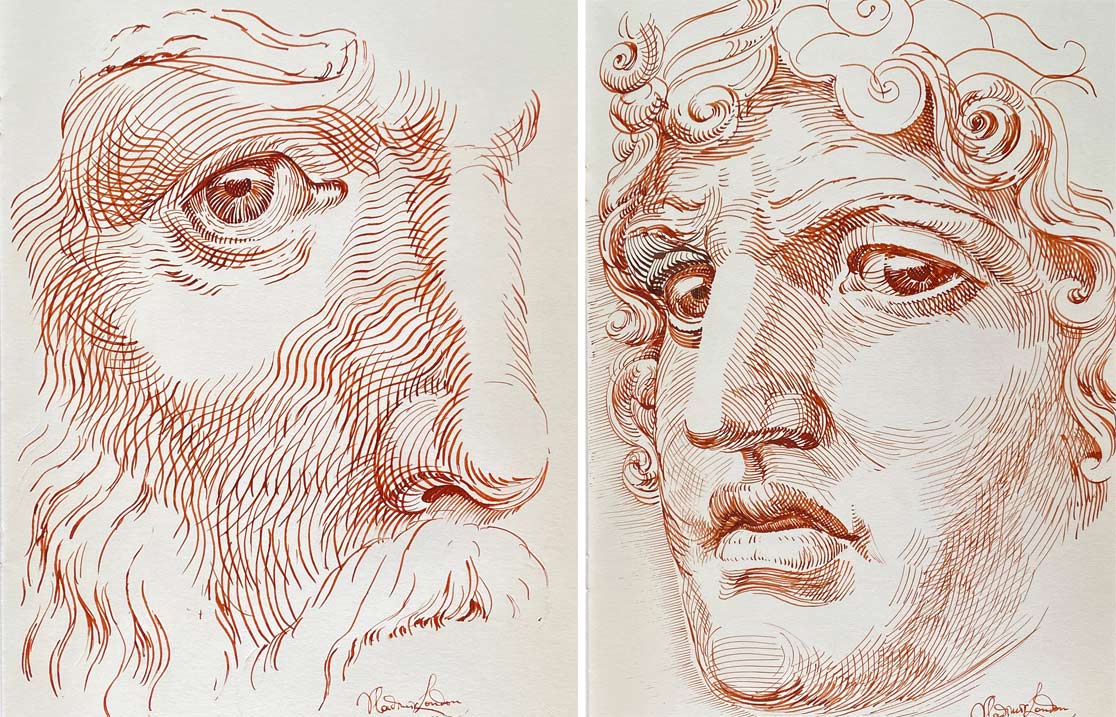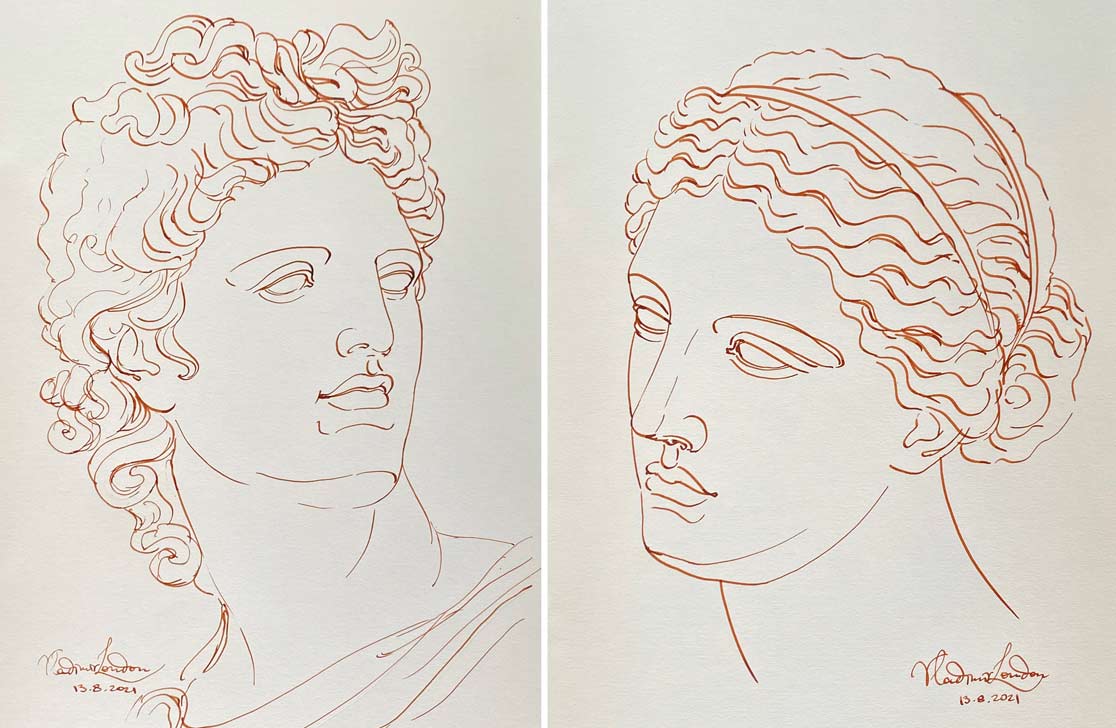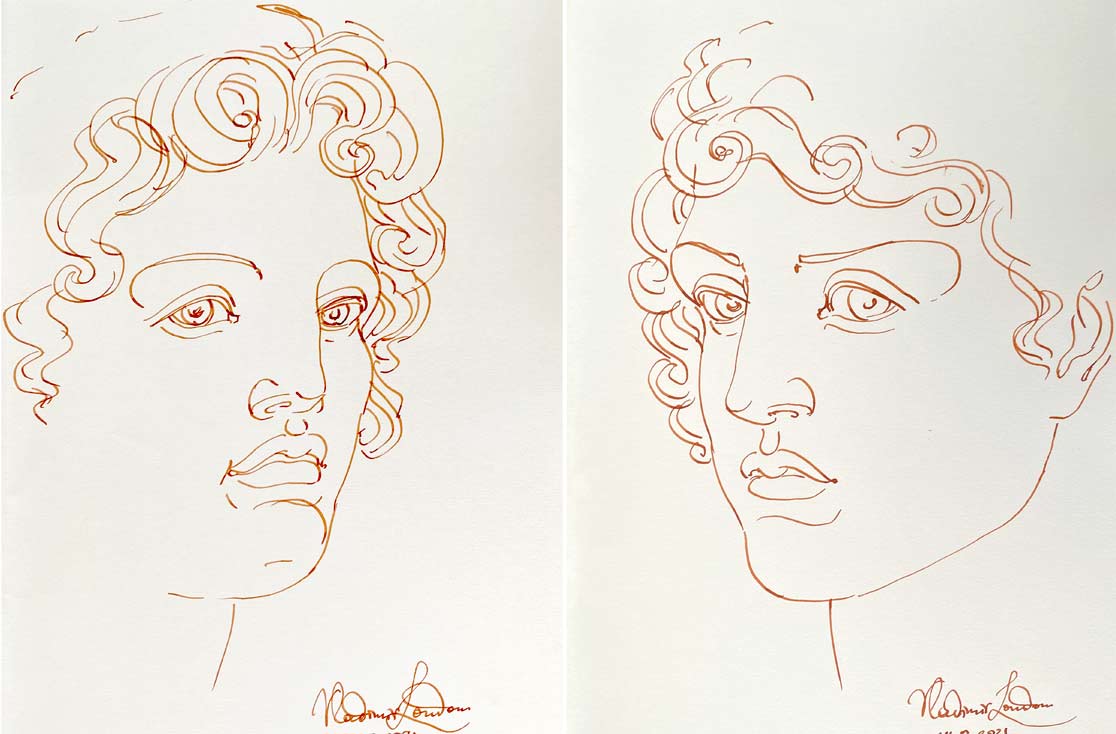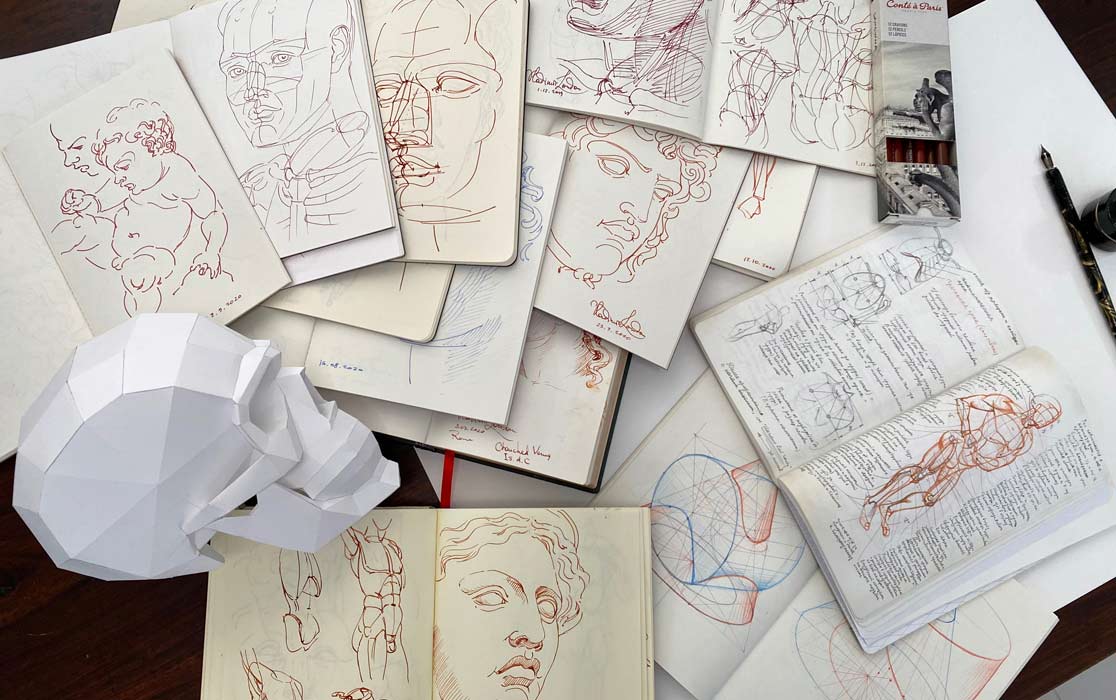Sketching Five Portraits a Day
Enroll in the Life Drawing Academy now!
How to get good drawing skills by making 5 portraits a day
By Vladimir London
Many beginning artists think that getting good drawing skills requires a lot of time. They also believe that drawing portraits is difficult. Lack of time is one of classic excuses. I will show you how to get good drawing skills with little effort at your end. You need to make sketches on a daily basis.

I fill my books with various sketches, mostly portraits, figures, anatomy, and other things. The drawing medium I use is pen and ink; this choice is not accidental. I was using different mediums for sketching for many years. I used to sketch in graphite pencil, colored pencils, ball pen, gel pen, and even in silver-point. Finally, I settled down on pen and ink because it is a laconic and unforgiving medium. Every line in ink is final and plays its role in the artwork. It develops confident drawing style because you cannot erase lines. This makes you to care about every line you draw. If you make some mistake, that's it – you have a mistake. If you see that mistake, that is great. You learn from it. Next time, you try to avoid it. Instead of erasing and redrawing, ink forces you to keep going. It is easier and faster to make another sketch than to scrape ink marks with a scalpel or craft knife and redraw over it. This is what makes pen and ink so great for practicing – you have no choice, but to draw sketch after sketch to make them better.
Even when making fast sketches, an artist has to use the knowledge of proportions and anatomy, especially when drawing from imagination because there is no model to check proportions on. Needless to say, it is only possible when you know those proportions and rules of drawing facial features. Here's a quick test – can you name 20 proportions and alignments of a human head? If not, how would you make sure they are correct in your drawing? What measuring guides would you use to draw a realistic portrait? Here's another challenge with sketching from imagination – even if you know all the proportions, anatomy and alignments, you still need good drawing skills to apply your knowledge on paper. This is what sketching really helps with – developing good drawing skills when you have no pressure of making perfect drawings every single time.

Many artists complain that they have some kind of artist-block, which prevents them from making art. I've heard this excuse so many times. One of the reasons why an artist might stop drawing is a subconscious fear of failure. If someone expects to make a beautiful artwork, but is not sure about the outcome, this could be a reason for artist's block. Here's the thing – if you have no expectations of making a wonderful piece of art every single time, then you have nothing to be disappointed with – your sketch will come out as your skills permit. If a sketch looks very bad, I'm sure you already knew that your drawing skills are not perfect and there is a room for improvement. This is what you make sketches for anyway – to develop a good drawing style, to learn new things about proportions and anatomy, to capture your thoughts and ideas and who cares that some sketches come out worse than others.
I will tell you a secret. If you place all drawings you have ever done in the sequence from bad to good, 50% of your artworks will be worse than your average piece, regardless how good your level of drawing skills is. Of course, the word "average" here means your average ability, not someone else. And the aim of this game is to constantly push your skills higher. This can only be done by making more and more artworks. With every new artwork you do, you have an opportunity to place it in the category "above your average". This will make your average level rise, together with the level of your drawing skills. Nevertheless, 50% of your artworks will be lower than your new average no matter how hard you work because this average level is not fixed, but moving together with your skills and artworks you produce. So, I hope this busts the artist-block excuse. Statistically, your 50% mark will always be there. At any given time, half of your artworks will be below your average ability of making good pieces of art.

Quantity inevitable transfers into quality. As long as you practice drawing, learn good techniques, and apply what you know on paper, your drawing skills cannot stay the same, they will rise.
For many portraits, I take inspiration from ancient Greek and Roman sculptures that are known for classical proportions and beauty. Learning classical canons of proportions is a very important topic for every figurative artist and sculptor. What ancient artists developed more than 2000 years ago is still valid today. That is why in the Life Drawing Academy course, I explain and demonstrate in multiple video lessons numerous proportions of a human head, face and body. In this course, you can learn in depth three classical canons that are based on different measuring units.
There is no right or wrong canon. Canon is a set of rules, but a human figure is not set in stone. Every figure is different, so proportions vary from person to person in real life. The reason why it will be helpful for you to know classical proportions is because you can use that knowledge to see how your model deviates from that set of rules. It also will help you to draw from imagination. If you know that according the rules, the height of the nose is equal to the distance from the base of the nose to the chin, you can use this knowledge to draw from imagination well-proportionate portraits.

A one of my friends says, "drawing portraits is very easy, every child can do that". The challenge begins when you want to make not naïve, but beautiful and realistic portraits. This is when you need to know and use constructive drawing principles, human anatomy for artists, and head and face proportions. To do so, you need to learn the anatomy of a human skull, muscles beneath the skin, how those muscles create emotions on a face, what alignments, angles and checking points to use when drawing a portrait and how to use constructive drawing principles to build the portrait on paper in the correct sequential order. Of course, the topic of how to draw a portrait cannot be covered in one short video about sketching, that is why we created the whole course for figurative artists with more than 20 hours of video lessons where you can learn how to draw from life, memory and imagination realistic figures and portraits.
It is not a matter of time, quality, or drawing skills you have. It is about making a commitment of sketching on a daily basis. As long as you make multiple sketches every single day, your portrait drawing skills will improve with time. Of course, just sketching is not enough, you need to learn how to draw portraits the right way. This is what we can help you with – giving the necessary knowledge of how to draw portraits. This topic is fully explained in the Life Drawing Academy course.
Talking of this academy, there are two art courses there – the Online Course, the self-learn, self-paced video course where you can watch 52 lessons on how to draw portraits and figures from life, memory and imagination; and the Correspondence Course, in which you will receive personal tutoring from the academy teachers. The personal tutoring option is truly unique. Nowhere else you would get unlimited one-to-one tutoring for a lifetime for a one-time low fee. Should you take this course, academy tutors will assess your level of drawing skills and create a special curriculum just for you that will take into account your art skills level, your goals and your needs. This curriculum will cover all the gaps in drawing skills you have and give you the necessary knowledge of how to make figurative artworks. You will study under the personal guidance of tutors until you reach the advanced level of drawing skills.
Making portrait sketches is easier than you may think. You do not need a model, you do not need a reference photo, you just draw from memory and imagination the things you know about portrait drawing. For example, if you know that the line of eyes divides the height of the head in half, you apply that knowledge in your sketch. If you know that the distance between eyes is equal to the width of one eye, you make sure your sketch reflects this know-how. If you know that the height of the face can be divided into three equal parts – from the hair roots to the eyebrows, from that level to the base of the nose and from the nose to the chin, you do not need a model or a photo to depict this proportion. If you know that the distance from the base of the nose to the chin divided in half marks the bottom outline of the lower lip and the top half of that distance can be divided into three equal parts to mark the height of the upper lip, you can use this proportion by default when making a portrait sketch. There are many more proportions you need to know. However, if you do not know about those simple proportions, having a model would not help.
When I'm talking about 5 portraits a day sketching, these scribbles are not about quality, precision or beauty. It doesn't matter if sketches do not come out as intended or look so bad that you can't even show them to your grandma. What does matter, though, is that you make sketches with the intention of putting your knowledge on paper. This means that you need to use the knowledge of anatomy, proportions, and construction in every sketch you do.
There are right and wrong ways of making portrait sketches. If you copy a reference photo or doodle without thinking critically about constructive drawing, you waste your time. Such activity is called copying and doodling. Doodling won't develop your drawing skills; it will simply take your time. Copying is more dangerous. It will actually teach you the wrong set of skills. The more you copy from photos, the less you will be able to draw from life, memory and imagination. This is because the set of skills for copying will suppress your constructive drawing ability. There are many artists who cannot draw from life or imagination because they are used to copying flat images. Copying rewires one's brain to look at outlines and contours and copy those lines without understanding why they are there. Constructive drawing forces an artist to think about construction and anatomy, and therefore outlines and contours in such drawings become the sub-product of that knowledge rather than the primary means of making a picture.
If you have only 20 minutes a day, you can improve your portraits drawing skills by using those minutes wisely. It is not about time; don't tell me that you don't have 20 minutes a day. Do you know how many sketches you would do in one year should you do just 5 scribbles a day? More than 1800 sketches. How many portraits have you done in a last year?
Drawing is like playing music. If you do not draw for one day, you may notice your skills decline. If you do not draw for one week, professional artists might notice the difference. If you do not draw for one month, everyone will see that. For me, making sketches is the way to maintain my level of skills, to develop new styles, to think on new ideas, and to describe the sequence and logic of drawing steps among many other things. I do not worry about the quality of sketches. These are disposable exercises; they are not meant to be exhibited or published. It doesn't mean that you have to draw disproportionate images on purpose. But if your sketches come out with wrong proportions and you see that; this is much better than if you don't notice your mistakes and by repeating the same errors would become perfect at doing that.
The 5 portraits a day challenge doesn't necessarily mean that you have to draw portraits only. This is about getting into the good habit of sketching daily for at least 20 minutes. You can draw figures, anatomy, describe in writing and illustrate proportions of a human head, face and body, sketch ideas for future compositions and so on.
Drawing is a non-verbal language of communication. Making sketches is like having small-talks with someone. It is the way of thinking, the way of expressing ideas and sharing thoughts. The more you sketch, the more fluently you will be able to communicate, using this non-verbal language. Sketching portraits is the numbers game. You need to draw thousands of portraits to become good at it. Making five small sketches is a simple way to achieve that.
It doesn't matter what medium you chose, what type of sketchbooks you use, or what kind of fountain pen you buy. I won't answer questions about art materials because I do not want to support your procrastination and erroneous thinking that some drawing tools will give you better results. Rules of constructive drawing, human anatomy, perspective, classical canons of proportions will remain the same whatever pen or pencil you use. It is not about drawing tools, it is not about the paper you draw on, but it is about your skills that make your art beautiful and realistic. Learn the skills, they are for life. Drawing tools can be purchased any time.
I hope my example is inspirational enough for you to consider the "five portraits a day" tip. So, once again, by practicing just 20 minutes a day and drawing at least five portraits every time you sketch, is a great way to make more than 1,800 sketches per year. No one can do it for you, except you.
We can help you with good art education. You can learn strong drawing skills with us in the Life Drawing Academy course.
To learn good drawing techniques, enroll in the Life Drawing Academy course:
Online Course
A self-study, self-paced course for you to learn fundamental methods of classical drawing and improve life drawing skills by watching video lessons and doing assignments
- Unlimited access to 52 life drawing video lessons
- Lifetime membership without deadlines
- Unlimited support from the Academy tutors
- Constructive critique of your artworks
- Member access to the Academy's Art community
- Place in the Academy's Students Gallery
- Exclusive members-only newsletter and bonuses
- Life Drawing Academy Diploma of Excellence in your name
One-time payment - Lifetime membership
$297 USD
Personal Tutoring Online + Online Course
The ultimate choice if you who would like to receive personal, one-to-one tutoring from the Academy teachers, which is custom-tailored to your skills and needs
- Everything in Online Course, plus:
- Dedicated team of art tutors
- Assessment of your current level of drawing skills
- Personalized curriculum tailored to your skills and goals
- Up to 100 drawing tasks with by-task assessment
- Unlimited one-to-one personal coaching with detailed per-task instructions and feedback
- Artwork critiques and results-oriented guidance
One-time payment - Lifetime membership
$997 USD




